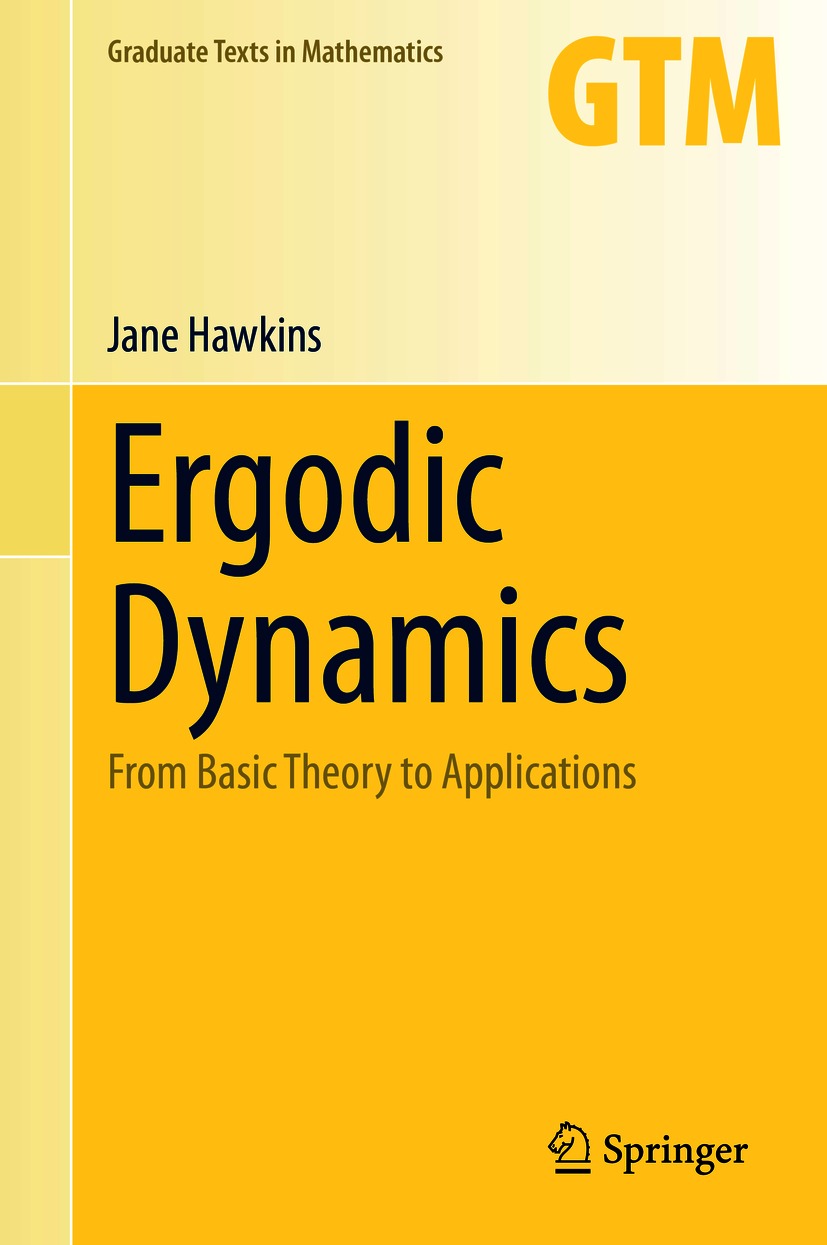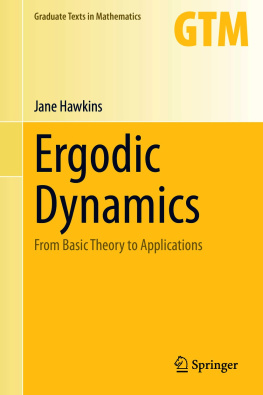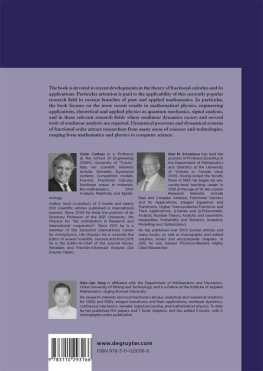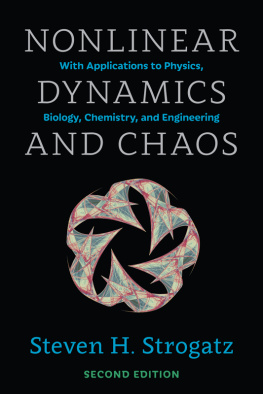Jane Hawkins - Ergodic Dynamics: From Basic Theory to Applications
Here you can read online Jane Hawkins - Ergodic Dynamics: From Basic Theory to Applications full text of the book (entire story) in english for free. Download pdf and epub, get meaning, cover and reviews about this ebook. year: 2021, publisher: Springer International Publishing, genre: Home and family. Description of the work, (preface) as well as reviews are available. Best literature library LitArk.com created for fans of good reading and offers a wide selection of genres:
Romance novel
Science fiction
Adventure
Detective
Science
History
Home and family
Prose
Art
Politics
Computer
Non-fiction
Religion
Business
Children
Humor
Choose a favorite category and find really read worthwhile books. Enjoy immersion in the world of imagination, feel the emotions of the characters or learn something new for yourself, make an fascinating discovery.
- Book:Ergodic Dynamics: From Basic Theory to Applications
- Author:
- Publisher:Springer International Publishing
- Genre:
- Year:2021
- Rating:5 / 5
- Favourites:Add to favourites
- Your mark:
- 100
- 1
- 2
- 3
- 4
- 5
Ergodic Dynamics: From Basic Theory to Applications: summary, description and annotation
We offer to read an annotation, description, summary or preface (depends on what the author of the book "Ergodic Dynamics: From Basic Theory to Applications" wrote himself). If you haven't found the necessary information about the book — write in the comments, we will try to find it.
Ergodic Dynamics: From Basic Theory to Applications — read online for free the complete book (whole text) full work
Below is the text of the book, divided by pages. System saving the place of the last page read, allows you to conveniently read the book "Ergodic Dynamics: From Basic Theory to Applications" online for free, without having to search again every time where you left off. Put a bookmark, and you can go to the page where you finished reading at any time.
Font size:
Interval:
Bookmark:

Graduate Texts in MathematicsSeries Editors:Stanford University bridge the gap between passive study and creative understanding, offering graduate-level introductions to advanced topics in mathematics. The volumes are carefully written as teaching aids and highlight characteristic features of the theory. Although these books are frequently used as textbooks in graduate courses, they are also suitable for individual study. bridge the gap between passive study and creative understanding, offering graduate-level introductions to advanced topics in mathematics. The volumes are carefully written as teaching aids and highlight characteristic features of the theory. Although these books are frequently used as textbooks in graduate courses, they are also suitable for individual study. Ravi Vakil,
More information about this series at Advisory Board:University of British ColumbiaUniversity of California, BerkeleyMSRIUniversity of Notre DameUniversity of Oregon http://www.springer.com/series/136 Alejandro Adem, David Eisenbud, & Brian C. Hall, Patricia Hersh,
J.F. Jardine,University of Western Ontario Jeffrey C. Lagarias,University of Michigan
Eugenia Malinnikova,Stanford University
Ken Ono,University of Virginia Jeremy Quastel,University of Toronto Barry Simon,California Institute of Technology
Steven H. Weintraub,Lehigh University
Melanie Matchett Wood,Harvard University

This Springer imprint is published by the registered company Springer Nature Switzerland AG
The registered company address is: Gewerbestrasse 11, 6330 Cham, Switzerland
To Michael and Diane
The word ergodic is one of many scientific portmanteau words that were assembled from Greek words, in this case by mathematical physicists. They produced a new label for a type of dynamical behavior exhibiting some uniform randomness. Words for work (ergon) and path (odos) were combined to give ergodic; but, why was that meaningful? To make sense of work-path, we consider a system of many moving particles, such as a fluid, with the property we can understand the entire system reasonably well by measuring and averaging the work done along just one randomly chosen orbit path. Then, there is a certain intrinsic randomness exhibited by the dynamical system, since we do not know in advance which initial point of the more than 1027 possibilities to follow; we call this system ergodic. Another way to think of an ergodic dynamical system is to imagine that any randomly chosen point has an orbit that passes through a neighborhood of every possible state of the system, spending the right proportion of its time there through its recurring visits. Therefore, following the path of one point tells you about the entire system. Unfortunately, not all dynamical systems have this indecomposability to them, and not every point in an ergodic system will unlock the behavior of the whole system. It is in understanding whys or why nots, the basic examples, and stronger related properties that we get into the beautiful mathematics of the subject of ergodic theory.
The term ergodic was coined by Boltzmann in the late 1860s in the context of the statistical mechanics of gas particles; it is relevant that he was wrong, or at least overly hopeful in his original conjecture that every classical system of interest was ergodic. The term was subsequently adopted by both mathematicians and physicists, its meaning bifurcated and mutated over the decades, and it currently means slightly different things to mathematicians, applied mathematicians, and physicists. Vocabulary that comes into existence in this contrived way frequently leaves most readers out in the cold. One goal of this text is to show that the mystery surrounding ergodic theory is unwarranted. The subject could just as easily be called dynamical systems, except that studying the subject using only topology and calculus does not capture the essence of the probabilistic randomness involved in an ergodic system. We study topological dynamical systems in this book too, as the interplay between the topological and statistical properties in many physical and natural examples is what lends so much beauty to the subject. In fact, from the start, we give all of our dynamical systems both topological and measurable structure to avoid deciding which tool kit we can use; we hope to show the reader how to use both interchangeably.
Font size:
Interval:
Bookmark:
Similar books «Ergodic Dynamics: From Basic Theory to Applications»
Look at similar books to Ergodic Dynamics: From Basic Theory to Applications. We have selected literature similar in name and meaning in the hope of providing readers with more options to find new, interesting, not yet read works.
Discussion, reviews of the book Ergodic Dynamics: From Basic Theory to Applications and just readers' own opinions. Leave your comments, write what you think about the work, its meaning or the main characters. Specify what exactly you liked and what you didn't like, and why you think so.





![Eisner Tanja - Operator Theoretic Aspects of Ergodic Theory [recurso electrónico] $c](/uploads/posts/book/173124/thumbs/eisner-tanja-operator-theoretic-aspects-of.jpg)







